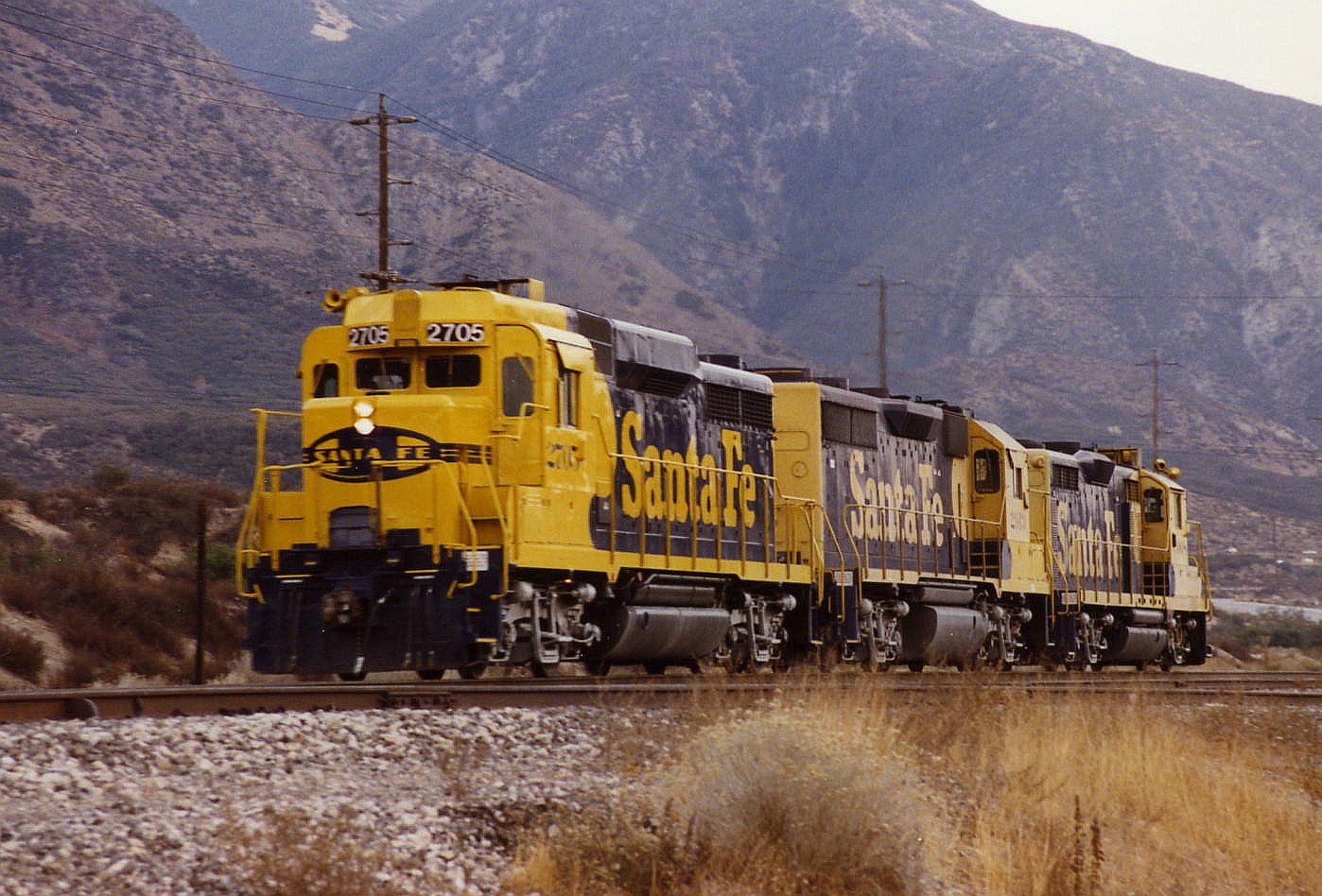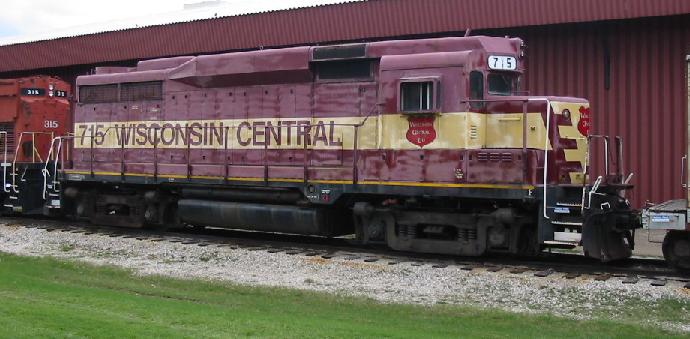- EMD GP30
Infobox Locomotive Auto
name=EMD GP30
powertype=Diesel-electric


caption=A GP30, GP35, and GP20 run light in the late 1980s onCalifornia 'sCajon Pass .
builder=GM-EMD
caption2=WC 715 at theNational Railroad Museum in Green Bay, WI
aarwheels=B-B
cylindercount=V16
primemover=EMD 567 D3
builddate=July 1961 – November 1963
totalproduction=948
locale=North America
poweroutput=2,250 hp (1,680 kW)
topspeed=78 mph (126 km/h)
weight=253,000 lb (115,000 kg)
tractiveeffort=63,375 lbf (282 kN)
length=56 ft 2 in (17.12 m)
enginetype=2diesel
aspiration=turbocharger
cylindersize=8.5 in × 10 in (215.5 mm × 254 mm)
displacement=9,072 in³ (148.7 L)
transmission=DC generator, DC traction motors
locobrakes=Straight air, Dynamic
coolantc
oilc
fuelc
sandbox = 18 cu.ft.
buildmodel = GP 30The EMD GP30 was a 2,250 hp (1,680 kW) four-axle B-Bdiesel locomotive built by General Motors General Motors Electro-Motive Division ofLa Grange, Illinois between July, 1961 and November, 1963. 948 examples were built for railroads in theUnited States andCanada (2 only), including 40 cablessB unit s for theUnion Pacific Railroad .It was the first so-called "second generation" EMD diesel locomotive, and was produced in response to increased competition by a new entrant, General Electric's U25B, which was released roughly at the same time as the GP30. The GP30 is easily recognizable due to its high profile and stepped cab roof, unique among American locomotives. A number are still in service today in original or rebuilt form.
History
Development
The GP30 was conceived out of the necessity of matching new competitor GE's U25B. The U25B offered 2,500 hp (1,900 kW) while EMD's GP20 and its 567D2 prime mover was only rated at 2,000 hp (1,500 kW). It also featured a sealed, airtight long hood with a single inertial air intake for electrical cooling, with a pressurized cooling system which kept dust out of the engine and equipment area. Finally, the entire design was optimized for ease of access and maintenance. The U25B demonstrators were receiving much praise—and orders—from the railroads that tested them. Meanwhile, ALCO had been producing the 2,400 hp (1,800 kW) RS-27 since 1959, though it had not sold well.
EMD's engine department managed to get an extra 250 hp (186 kW) out of the V16
EMD 567 -series engine; the new engine was designated the "EMD 567D3". 2,250 hp (1,680 kW) wasn't quite equivalent to the GE and ALCO offerings, but EMD hoped the railroads' familiarity with EMD equipment would improve their chances. The locomotive in which it would be fitted was improved along the lines of the U25B; sealed long hood, central air intake, and engineered for easier maintenance access. The frame and trucks of the GP20 were carried across; the extra equipment for the centralized air system required more space behind the cab, and since the locomotive was not going to be lengthened, extra space was achieved vertically by raising the height of the locomotive, giving room for the central air system, turbocharger and electrical cabinet all behind the cab. This extra height behind the cab meant that the body style used for previous GP units was not suitable.Since EMD needed the new locomotive to be visibly modern and updated, they turned to the GM Automotive Styling Center at
Troy, Michigan for help. The automobile stylists created the GP30's trademark "hump" and cab roof profile. The hump-like bulge started at the front of the cab and enveloped the air intakes for the central air system and the dynamic brake blister. Units ordered without dynamic brakes were the same shape, but lacked the intakes to cool the dynamic brake resistor grids.For the first time on an EMD
hood unit , a low short hood was the default. A high short hood could be ordered, but only holdoutsNorfolk and Western Railway and Southern Railway received such units. EMD originally planned to name the locomotive the GP22, and the first demonstrators were put out under that number, but EMD's marketing department decided to leapfrog GE's numbering to make the new locomotive seem more advanced. Marketing literature claimed 30 distinct improvements from the GP20 and that this was the reason for the number.ales and in service
The GP30 successfully countered the GE threat and kept EMD in the dominant position in the North American diesel market. While losing a little power to the GE and ALCO competition, the solidity and reliability of the GP30—and the familiarity of railroad mechanical departments with EMD products—ultimately won many more orders for EMD. 948 were sold, in comparison to 478 U25Bs. In addition, the GP30 was only sold until the end of 1963, while the U25B was available until 1966.Most major railroads ordered GP30s, and many smaller ones did too. The largest orders were from the UP (152), SOU (120), ATSF (85), and the B&O (77). The sole purchaser of
B unit s (by the mid 1960s generally an outdated concept) was the UP, who kept the practice of running its locomotives in matched sets much longer than others. Eight of those 40 B units were fitted with steam generators for heating passenger trains, the only GP30s to receive them.Some units for the GM&O, MILW and SOO were built from ALCO trade-ins and ride on ARR type B trucks instead of the standard
Blomberg B s. An indisputable tribute to the quality of the GP30 design is the fact that a good number are still in service as of 2007, which is a service lifespan of over 40 years and well in excess of the design life of 25-30 years for the average diesel locomotive. Furthermore, when life-expired, some railroads chose to give them major rebuilds instead of scrapping them.Original buyers
Cab-equipped 'A' units
Cabless booster 'B' units
Rebuilds
The
Burlington Northern Railroad was the most extensive rebuilder of GP30s. Finding a need for modernized units of lower power, it sent GP30s—-both its own and units purchased from other railroads-—to be rebuilt. Seventy units were sent to EMD and 65 toMorrison Knudsen (nowWashington Group International ) for rebuilding, and the rebuilds are known as GP39E and GP39M respectively. The changes included new generators, Dash-2 modular electronic control systems and 567D3 engines upgraded withEMD 645 -series power assemblies, rated at 2,300 hp (1,720 kW) and designated 16-645D3. These units are still in service on local and smaller lines throughout theBNSF Railway system.The
Atchison, Topeka and Santa Fe Railway (ATSF), meanwhile, performed a similar upgrade in its ownCleburne, Texas shops, stripping the locomotives down to bare metal and rebuilding with new equipment. The 567 engines retained their 2,250 hp (1,680 kW) rating but were upgraded with 645-series power assemblies. The generators and traction motors were upgraded and control and electrical equipment was replaced. The trucks received Hyatt roller bearings and single-clasp brake systems. Rooftopair conditioner s and new horns were added. The locomotives were repainted in the blue and yellow "Yellowbonnet" scheme, and designated GP30u (for "upgraded"). 78 of these survived until the BNSF merger, and most are still in use in secondary service.Preserved Units
According to John Komanesky's "Preserved Diesels" site, 16 GP30s have been preserved by a variety of museums, societies and tourist railways. A number of these preserved locomotives are in operational condition.
*
Union Pacific GP30 849 is in the collection of theWestern Pacific Railroad Museum and is operational.
*Union Pacific 844, the engine that necessitated the numbering of UP steam engine from 844 to 8444 for a time, is preserved and in use at the Nevada State Railroad Museum/Boulder City, also known as theNevada Southern Railroad Museum .
*The Western Maryland Scenic Railroad owns two GP30s which formerly belonged to the Pennsylvania and Reading Railroad. Currently numbered 501 and 502, at least one the locomotives is in active service. It is either used by itself or in conjunction with the railroad's Baldwin steam locomotive for its dynamic braking ability.
*Southern #2601 is preserved and operational at the NCTM in Spencer, NC.
*A former PRR engine, currently painted in a Conrail scheme, is at the Railroad Museum of Pennsylvana. It is believed to be serviceable.
*The first production GP30, a Reading unit, is preserved by the Reading Company Technical & Historical Society in Hamburg, PA. Operational in the 1980s and 1990s, it is currently awaiting repair.
*Cotton Belt 5006 is at the Arkansas Railroad Museum in Pine Bluff.
*Southern 2594 is preserved at the Southeastern Railway Museum in Duluth, GA and is operational.
*Soo Line 703 is preserved at theColfax Railroad Museum in Colfax, WI.References
* Goodman, Eric. " [http://www.qstation.org/EricGoodman/ericgoodman_gp30u.html ATSF GP30u Project] ". Retrieved on
February 1 ,2005 .
*
*
*
* Komanesky, John. " [http://www.thedieselshop.us/PRSVDemdOthers.HTML Preserved EMD Locomotives: All except Cab Units and Switchers] ". Retrieved onFebruary 2 ,2005 .
*
* Sarberenyi, Robert. " [http://users.inna.net/~jaydeet/gp30.htm EMD GP30 Original Owners] ". Retrieved onAugust 27 ,2006
* Strack, Don. " [http://utahrails.net/webpubs/up-gp30s.php Union Pacific's EMD GP30s] ". Retrieved onFebruary 2 ,2005 .
* Trainpix.com. " [http://archive.trainpix.com/bnsf/ROSTER.HTM BNSF Motive Power Roster] ". Retrieved onFebruary 1 ,2005 .
Wikimedia Foundation. 2010.



_2,600(opt))